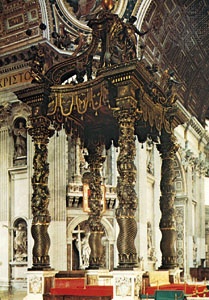baldachin
architecture
also spelled baldachino, or baldaquin, also called ciborium
 in architecture, the canopy over an altar or tomb, supported on columns, especially when freestanding and disconnected from any enclosing wall. The term originates from the Spanish baldaquin, an elaborately brocaded material imported from Baghdad that was hung as a canopy over an altar or doorway. Later it came to stand for a freestanding canopy over an altar.
in architecture, the canopy over an altar or tomb, supported on columns, especially when freestanding and disconnected from any enclosing wall. The term originates from the Spanish baldaquin, an elaborately brocaded material imported from Baghdad that was hung as a canopy over an altar or doorway. Later it came to stand for a freestanding canopy over an altar.Early examples of the baldachin are found in Ravenna and Rome. The characteristic form consists of four columns supporting entablatures, which carry miniature colonnades topped by a pyramidal or gabled roof. In Romanesque work, arches generally replaced the entablatures, and gables frequently topped the four sides, as is the case in the Church of San Ambrogio in Milan. Few baldachins of the Gothic period remain, and their use outside Italy seems to have been intermittent; there is, however, a rich Gothic example in the Sainte-Chapelle at Paris (1247–50), reconstructed by Eugène-Emmanuel Viollet-le-Duc in the 19th century. In the Renaissance the use of the baldachin became more common, and during the 17th century elaborate structures were built, probably as a result of the influence of the enormous bronze baldachin that Gian Lorenzo Bernini designed for the altar of St. Peter's in Rome.
- Catoche, Cape
- Cato, Marcus Porcius
- Cato Maximilian Guldberg
- Catonsville
- Caton-Thompson, Gertrude
- Cato, Publius Valerius
- Catron, John
- Catroux, Georges
- cat scratch disease
- cat's-eye
- cat shark
- Cats, Jacob
- Catskill Delta
- Catskill Game Farm, Inc.
- Catskill Mountains
- cat snake
- cattail
- Cattaneo, Carlo
- Cattaraugus
- Catt, Carrie Chapman
- Cattelan, Maurizio
- Cattell, James McKeen
- Cattell, Raymond B.
- cattle
- Cattle Raid of Cooley, The